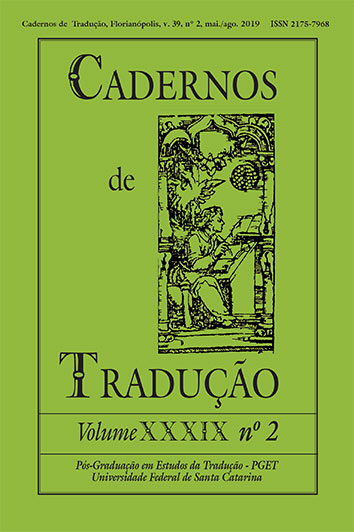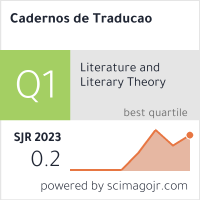Translating motion verbs from english to portuguese: Lexicon and constructions
DOI:
https://doi.org/10.5007/2175-7968.2019v39n2p166Abstract
Based on Cognitive Linguistics, we investigate the use of motion verbs in English and Brazilian Portuguese basketball broadcasts and its implications for translation. This corpus, which represents a natural context of spoken language, included two National Basketball Association games. We found a total of 104 motion verb occurrences, 51 in English and 53 in Brazilian Portuguese, consisting of 46 different types in English and 26 in Brazilian Portuguese. This suggests that the broadcasts are somewhat equivalent in style, since a similar number of verbs were used in both languages. However, the variety of motion verbs and their meaning were asymmetrical. A wider variety of motion verbs is used in English than in Brazilian Portuguese. Moreover, in English, there is a tendency to use verbs that encode MANNER in the verb root. In Brazilian Portuguese, on the other hand, the preferred verbs are less specific, encode PATH and provide less information about the manner of motion. Such differences are the source of the difficulties for translatingmotion verbs from English to Portuguese. For translation studies, this study corroborates the Unique Items Hypothesis, according to which an item is unique in a given language inasmuch as its grammatical contexts are unique in that language.
References
Aronoff, M.; Fudeman, K. What is Morphology? 2ª ed. Nova Jersey: Wiley-Blackwell, 2011.
Beavers, J; Levin, B.; Tham, S. W. The typology of motion expressions revisited. Journal of Linguistics, vol. 46, N. 2, p. 331-377, 2010.
Cappelle, B. English is less rich in manner of motion verbs when translated from French. Across Languages and Cultures 13 (2), p. 173–195, 2012.
Filipovic, L. Typology in action: applying typological insights in the study of translation. International Journal of Applied Linguistics. Vol. 18-1, 2008, p. 23-40.
Goldberg, A. Constructions: A construction grammar approach to argument structure. Chicago: Chicago University Press, 1995.
Lakoff, G.; Johnson, M. Women, fire and dangerous things: what categories reveal about the mind. Chicago: The University of Chicago Press, 1987.
Levin, B.; Rappaport, M. Manner and Result: A View from clean. In: Pensalfini, R.; Turpin, M.; Guillemin, D. (Orgs.). Language Description Informed by Theory. John Benjamins: Amsterdã, 2014. p. 337-357.
Moura, H; Berger, I. R. Verbos e satélites na língua inglesa. In: Moura, H; Mota, M; Santana, A. P. (Org.). Cognição, Léxico e Gramática. 1 ed. Florianópolis: Insular, 2012, p. 51-65.
Moura, H.; Silva Junior, I. A representação do espaço nos verbos: os sentidos do movimento. In: Aragão Neto, M; Cambrussi, M. (Orgs.). Léxico e Gramática: novos estudos de interface. 1ª ed. Curitiba: Editora CRV, 2014, p. 69-87.
Papafragou, A.; Massey, C.; Gleitman, L. When English proposes what Greek presupposes: The cross-linguistic encoding of motion. Cognition 98, 2006.
Rogers, T.; McClelland, J. Semantic cognition: a parallel distributed processing approach. Londres: The MIT Press, 2004.
Rosch, E. Principles of categorization. In: Rosch, E.; Lloyd, B. B (Orgs.). Cognition and categorization. Hillsdale: Lawrence Erlbaum, 1978. p. 27-48.
Santos Filho, D. A expressão do modo de movimento no português brasileiro. Tese (Pós-Graduação em Linguística), UFSC, Florianópolis, 2018.
Santos Filho, D.; MOURA, H. Padrões de lexicalização no português brasileiro. Signo, v. 41, n. 71, set., 2016.
Slobin, D. From “thought and language” to “thinking for speaking”. In: Gumperz, J. J.; Levinson, S. C. (Orgs.). Rethinking linguistic relativity. Nova Iorque: Cambridge University Press, 1996a. p. 70-96.
Slobin, D. Two ways to travel: verbs of motion in English and Spanish. In: Shibatani, M.; Thompson, S. A. (Orgs.). Grammatical constructions: their form and meaning. Oxford: Clarendon Press, 1996b. p. 195-219.
Slobin, D. The universal, the typological and the particular in acquisition. In: Slobin, D. (Org.). The crosslinguistic study of language acquisition. Londres: Lawrence Erlbaum Associates, 1997.
Slobin, D. Language and thought online: cognitive consequences of linguistic relativity. In: Gentner, D.; Goldin-Meadow, S. (Orgs.). Language in mind: advances in the study of language and thought. Cambridge, MA: MIT Press, 2003.
Slobin, D. The many ways to search for a frog: Linguistic typology and the expression of motion events. In: Strömqvist, S.; Verhoeven, L. (Orgs.). Relating events in narrative: v. 02. Typological and contextual perspectives. Mahwah, NJ: Lawrence Erlbaum Associates, 2004.
Slobin, D. Relating Narrative Events in Translation. In: Ravid, D.; Shyldkrot, H. B. (Orgs.). Perspectives on language and language development: Essays in honor of Ruth A. Berman. Dordrecht: Kluwer, 2005.
Slobin, D. What makes manner of motion salient? Explorations in linguistic typology, discourse and cognition. In: Hickmann, M.; Robert, S. (Orgs.). Space in Languages: Linguistic Systems and Cognitive Categories. Amsterdã / Nova Iorque, John Benjamins, 2006. p. 59-82.
Talmy, L. Lexicalization patterns: Semantic structure in lexical forms. In: Timothy Shopen, ed. Language Typology and Syntactic Description, v. 03. Grammatical Categories and the Lexicon. Cambridge: Cambridge University Press. 1985, p. 57-149.
Talmy, L. Toward a Cognitive Semantics. Cambridge, MA: MIT Press. 2000.
Talmy, L. The fundamental system of spatial schemas in language. In: Hampe, B. (Org.). From perception to meaning: image schemas in cognitive linguistics. Berlim: Mouton de Gruyter, 2006.
Downloads
Published
How to Cite
Issue
Section
License
Copyright Notice
Authors hold the copyright and grant the journal the right for their articles' first publication, being their works simultaneously licensed under the Creative Commons Attribution License (CC BY), which allows the sharing of such works with its authorship acknowledged and its initial publication in this journal.
Authors are allowed to enter into separate additional contractual arrangements for the non-exclusive distribution of the journal's published version of the work (e.g., post it to an institutional repository or as a book chapter, with an acknowledgment of its initial publication in this journal).










































